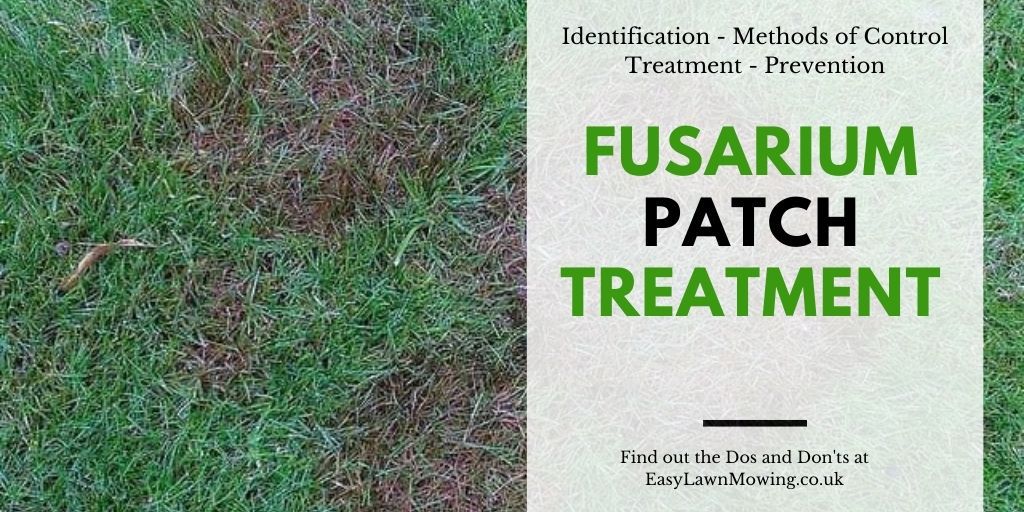
In this article, we will be discussing the importance of correctly identifying lawn diseases, as the treatment varies depending on the specific disease. Brown Patch, Rust, and Dollar Spot are some of the most common lawn diseases, but we will be focusing on the most damaging and difficult to control disease – Fusarium Patch.
Fusarium Patch is most noticeable towards the end of the season and throughout winter until early spring, but it can also withstand temperatures up to 19°C, meaning it can appear during the summer and spring months too. This disease can happen anywhere and to any type of lawn, and once established, it can kill the grass, leaving behind unsightly bare patches. To prevent, control and treat Fusarium Patch, we have compiled a list of tips that will give you the best chance of keeping your lawn healthy and disease-free.
Key Takeaways
- Correct identification of lawn diseases is crucial for effective treatment
- Fusarium Patch is the most damaging and difficult to control lawn disease
- Applying preventative measures can help keep your lawn healthy and disease-free.
Identification
Fusarium patch disease is a fungal disease that attacks grass plants, causing brown patches on lawns. It is caused by the fungus Microdochium nivale, which produces spores that infest the grass. The disease is most common in cool, damp conditions and can be identified by the appearance of small yellow circles on the grass surface. As the disease progresses, the patches become darker until they turn into a dirty shade of yellow. In severe cases, the edges of the patches turn brown and white or pink mycelium may grow. Fusarium patch disease can spread quickly, so it is important to treat it promptly. High nitrogen levels and thatch layer can contribute to the growth of the disease. Other common lawn diseases include red thread and snow mould, which have a shorter incubation period compared to Fusarium patch disease.
Methods of Control

To effectively control Fusarium within your lawn, it is important to follow proper lawn maintenance practices. This includes regular mowing, feeding, and aerating. However, there are also specific methods of control that can be implemented to combat the disease.
One method of control is the use of fungicides. While this can provide short term relief, it is important to note that fungicides can also kill helpful disease and fungi that promote the breakdown of thatch and organic matter within the soil. Additionally, if the weather conditions are suitable for fungus growth, the patch will just re-grow shortly after application.
A more effective method of control is to regularly aerate and scarify the lawn. This removes dead grass and debris, allowing for better penetration of air into the grass roots and improves drainage within the soil. This can reduce the likelihood of reoccurrence of the disease. Applying a topdressing to cover existing thatch can also dilute it, aiding in its natural breakdown.
It is important to note that Fusarium can survive within the layer of thatch on top of your lawn. Therefore, proper maintenance practices and specific methods of control should be implemented to combat the disease. By doing so, your lawn should be strong enough to combat the patches on its own without needing any extra precautions or large repairs.
Some additional methods of control include:
- Ensuring proper moisture levels by addressing both surface moisture and drainage issues. Poor drainage can lead to the build-up of moisture, creating a suitable environment for the growth of Fusarium.
- Improving aeration and airflow by spiking the lawn and pruning any overhanging shade trees. This can reduce compaction and allow for better air circulation.
- Removing dead plant material, as it can provide a breeding ground for the disease.
- Applying nitrogen to the lawn, as it can help boost the grass’s natural defences against disease.
By implementing these methods of control, you can effectively combat Fusarium within your lawn and maintain a healthy, vibrant lawn.
Treatment
Best selling Fusarium treatment

When it comes to treating Fusarium, there are various options available to us. However, some products have proven to be more effective than others. Based on customer reviews and sales figures, the best selling Fusarium treatment is Scotts DiseaseEx Lawn Fungicide.
This autumn fertiliser treatment contains a high amount of nitrogen fertiliser, which helps to promote healthy grass growth and prevent the spread of Fusarium. It also includes a fungicide that provides fungicidal control against the disease.
To use this product, simply apply it to your lawn using a spreader or by hand. It is recommended to apply it in the autumn when the weather is cooler and the grass is growing more slowly. This will give the fertiliser time to soak into the soil and be absorbed by the grass roots.
In addition to using a fungicide and fertiliser, it is important to take other measures to control Fusarium. This includes aerating your lawn, pruning overhanging branches, and keeping the affected area damp. By following these steps and using the best selling Fusarium treatment, we can effectively treat and prevent the spread of this disease.
Prevention
To prevent Fusarium patch, it is essential to maintain a healthy lawn all year round. This means following proper lawn care procedures, which include providing sufficient light, air, water, and nutrition to the grass. Here are some tips to help you prevent Fusarium patch:
-
- Lawn maintenance: Regular mowing, aerating, and dethatching can help maintain a healthy lawn.
- Watering: Water the lawn deeply and infrequently, preferably in the morning, to allow the grass to dry out during the day.
- Fertilizing: Apply a balanced fertilizer in the spring and autumn to provide the grass with the necessary nutrients.
- Snow removal: Remove snow from the lawn as soon as possible to prevent the grass from suffocating and developing Fusarium patch.
- Reduced daylight hours: During the winter months, when daylight hours are reduced, it is important to keep the grass as dry as possible to prevent the development of Fusarium patch.
- Morning mists and dews: Avoid watering the lawn in the evening or at night, as this can cause moisture to accumulate on the grass, which can lead to the development of Fusarium patch.
- Climatic and weather conditions: Keep an eye on the weather and adjust your lawn care routine accordingly. During periods of high humidity, for example, it is important to reduce watering to prevent the grass from becoming too moist.
By following these prevention measures, you can keep your lawn healthy and reduce the risk of Fusarium patch. Remember to also regularly check your lawn for signs of disease and take action promptly if you notice any issues.
Fusarium Treatment Video
Frequently Asked Questions
What treatments are effective against Fusarium patch on golf greens?
We recommend using fungicides that contain azoxystrobin, propiconazole, or triticonazole. These have been proven to effectively control Fusarium patch in golf greens. It is also important to properly manage the turfgrass and avoid over-fertilisation, as this can increase susceptibility to the disease.
Which fungicide is most effective for controlling Fusarium in lawns?
For controlling Fusarium in lawns, we suggest using fungicides that contain azoxystrobin, propiconazole, or tebuconazole. These have been shown to be effective in controlling the disease. However, it is important to note that fungicides should be used as part of an integrated management approach that includes proper mowing, watering, and fertilization practices.
What are the steps to manage Fusarium patch in grass areas?
To manage Fusarium patch in grass areas, we recommend the following steps: - Properly identify the disease through visual symptoms or laboratory testing. - Adjust the mowing height to reduce stress on the grass and promote healthy growth. - Avoid over-fertilization, as this can increase susceptibility to the disease. - Use fungicides as part of an integrated management approach. - Improve drainage in areas where water tends to accumulate.
How can one identify and treat lawn fungus, including Fusarium patch?
To identify and treat lawn fungus, including Fusarium patch, we suggest the following: - Look for visual symptoms such as circular patches of dead or discoloured grass. - Send a sample of the affected grass to a laboratory for testing. - Use fungicides as part of an integrated management approach. - Adjust the mowing height to reduce stress on the grass and promote healthy growth. - Improve drainage in areas where water tends to accumulate.
What are the best practices for preventing snow mould and Fusarium patch in grass?
To prevent snow mould and Fusarium patch in grass, we recommend the following best practices: - Avoid over-fertilization, as this can increase susceptibility to the diseases. - Adjust the mowing height to reduce stress on the grass and promote healthy growth. - Ensure proper drainage in areas where water tends to accumulate. - Use fungicides as part of an integrated management approach. - Avoid excessive thatch buildup, as this can create an ideal environment for disease development.
How can Fusarium patch be distinguished from other lawn diseases for accurate treatment?
To distinguish Fusarium patch from other lawn diseases, we suggest the following: - Look for visual symptoms such as circular patches of dead or discoloured grass. - Send a sample of the affected grass to a laboratory for testing. - Compare the symptoms to those of other common lawn diseases such as snow mould or dollar spot. - Use fungicides as part of an integrated management approach. - Adjust the mowing height to reduce stress on the grass and promote healthy growth.
As a seasoned expert in the field of garden power tools, I have dedicated over a decade to working with and reviewing a wide variety of lawn mowers. My extensive experience has allowed me to gain a deep understanding of the benefits and limitations of different types of mowers and garden tools.
Over the years, I have honed my skills in writing informative articles and creating helpful videos for various blogs and publications. This has given me the ability to not only recognise what makes a good lawn mower, but also to help you choose the perfect garden tool for your specific needs and requirements.
With my wealth of knowledge and expertise, I am confident that I can provide you with valuable insights and recommendations when it comes to selecting the right lawn mower for your lawn. So, whether you're looking for a battery cordless, electric, petrol, or robotic mower, you can trust in my expertise to guide you towards the best option for your garden.







